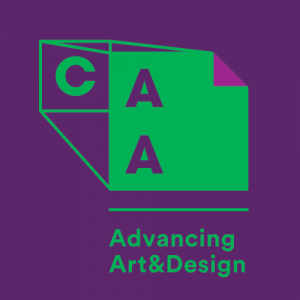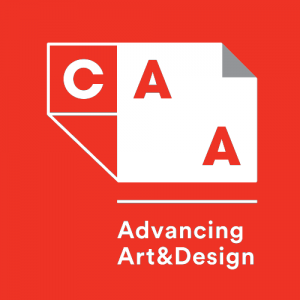CAA News Today
CAA Invites Proposals Related to Climate Crisis at 2021 Annual Conference
posted by CAA — February 26, 2020

Fridays For Future protest in Toronto, Canada. Photo: Jasmin Sessler
As part of the 2021 Annual Conference, CAA seeks to offer a selection of sessions, papers, speakers, and related programming on the topic of Climate Crisis. Including but going beyond eco-art and eco-criticism, and with climate justice and intersectional thinking as priorities, panels and presentations can address ecology as a matter of the content of artworks, but also, and pressingly, how we—artists, designers, and art historians, institutional stakeholders and independent practitioners, and members of allied fields—can and should change our professional practices in light of the crisis.
We invite discussions of creative interventions into the status quo, up to and including a serious discussion of ways of reducing the carbon footprint of the annual conference itself, while preserving and enhancing access. Practices and themes may include remediation and amelioration, thematic representation and critique, the ramifications of change for institutions and collections, issues of preservation, and the nature of research. We invite radical and practical proposals. The conference content will stress a broad and inclusive conversation on climate crisis impact through the lens of age; gender; nationality; race; religion; and socioeconomic status among others.
Memorial Celebration for Professor Victor Margolin at CAA 2020
posted by CAA — February 05, 2020

Image courtesy Bend Design Conference.
Please join us for a Memorial Celebration for Professor Victor Margolin during the 2020 Annual Conference on February 12, 2020.
Memorial Celebration for Professor Victor Margolin
Wednesday, February 12, 2020
5:30-7:30 pm
Resident’s Dining Room
Jane Addams Hull House
800 S. Halsted Street
Chicago, Illinois
If you’d like to attend, please RSVP to Rebecca Houze: rhouze@niu.edu
Victor Margolin (1941-2019) was Professor Emeritus of Design History at the University of Illinois at Chicago. He served on the CAA Board of Directors from 1993 to 1997 and was a frequent presenter and session chair at CAA’s Annual Conferences. He promoted the study of design and design history by encouraging the work of others and contributing to the activities of the Design Studies Forum. He was honored with Lifetime Achievement Awards for design research from LearnXDesign (2015) and the Design Research Society (2016). Victor was a founding editor of the academic design journal Design Issues. Books that he has written, edited, or co-edited include The Struggle for Utopia: Rodchencko, Lissitzky, Moholy-Nagy, 1917-1936; Design Discourse; The Designed World: Images, Objects, Environments; and The Politics of the Artificial: Essays on Design and Design Studies. He also edited and co-edited important volumes of essays on design titled Design Discourse (1989), The Idea of Design (1995) Discovering Design (1995) and The Designed World: Images, Objects, Environments (2002). The first two volumes of his World History of Design were published in April 2015.
In the words of his colleague and co-editor Bruce Brown, “Victor was a man of immense intellectual generosity and he mentored scholars young and old around the world. He was always a reasoned advocate of design as a tool to create societies that were more just, equitable and compassionate. These values were accompanied by a keen mind and twinkling eye that drew Victor to people all over the world. His deep humanity, ideas and insights will live on through books and essays to inspire future generations of designers.”
The Jane Addams Hull-House Museum is located on the campus of the University of Illinois at Chicago, 800 S. Halsted Street, Chicago. It is easily reached by public transportation using the UIC Halsted stop on the Blue Line or the Halsted Bus (#8), or via the Eisenhower Expressway (I-290) and the Dan Ryan Expressway (I-90). Parking is available at the Halsted and Taylor Street garage.
CAA Announces Guidelines for Addressing Proposed Cuts to Arts and Humanities Programs and Departments
posted by CAA — November 12, 2018
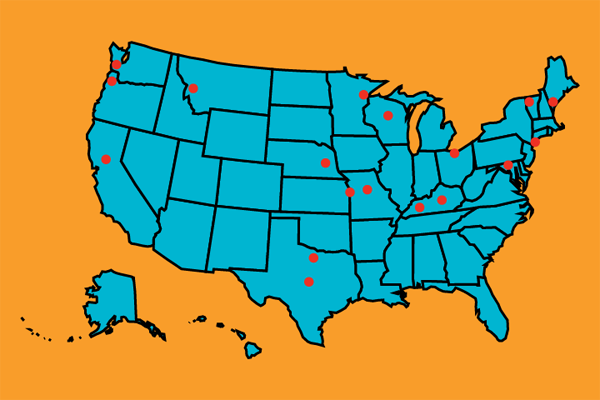
Campuses across the country have been affected by cuts to the arts and humanities. See the full list here. Graphic: Allison Walters
By any number of metrics, the arts and humanities are experiencing challenging times. Funding is under threat from the Federal government. Student enrollment is dropping in higher education classes focusing on the arts and humanities. The number of tenure-track faculty positions are diminishing in arts and humanities departments. The wide support of STEM-centered education has placed an emphasis on career paths with measurable and immediate financial outcomes. Yet, we know the importance of an arts and humanities education, not just for those looking to have careers in the arts and humanities but those across the entire professional spectrum.
In response to the challenges in the arts and humanities, some universities and colleges in the United States have cut programs, collapsed libraries, or shuttered entire departments. These steps, taken as cost-saving measures, only increase the uphill battle for the arts and humanities. Over the past years, CAA has tracked these changes in higher education through the organization’s own research efforts and through narratives relayed directly from our members. These actions taken by administrations are in no way secret. In article after article, the alarm has been sounded. We believe there is a better way to resolve these issues and protect the arts and humanities at the same time.
To bridge this divide, CAA is pleased to release “Guidelines for Addressing Proposed Substantive Changes to an Art, Art History or Design Unit, or Program at Colleges and Universities.”
“These guidelines provide a path for open communication between faculty and administration,” says Hunter O’Hanian, executive director of CAA. “With this new tool to be used by both administrations and faculty equally, CAA builds a resource that is vital to strengthening the arts and humanities on campuses. The guidelines create clearly definable steps and parameters for a process that when handled badly leads to fissures between faculty, students, and administrations.”
The “Guidelines for Addressing Proposed Substantive Changes to an Art, Art History or Design Unit or Program at Colleges and Universities” call for a deeper understanding of the factors and issues that have precipitated the action to close a department or program. The guidelines outline two clear paths: they encourage constituencies to communicate about the potential changes, and they pave the way to resolution without having to eliminate or downsize the program or department.
If those conversations fail to reach a satisfactory outcome with the educational institution, the guidelines emphasize that the institutional administration must do everything it can to see that the program continues. And, as is the case with all scholastic endeavors, the administrations must show their work—they must provide documentation that the department has been adequately resourced and funded. It must demonstrate that growth has been encouraged rather than to allowing it to lay fallow.
“CAA remains convinced that students and society derive lasting benefit when institutions offer a diverse range of academic resources to support different learning styles,” says Jim Hopfensperger, president of the CAA Board of Directors. “These new CAA guidelines outline best practices toward sustaining this essential diversity of academic programs and operational assets.”
Hopfensperger adds that “CAA believes that students, staff, faculty, and institutional leadership teams are all well served by inclusive processes, open lines of communication, engagement across constituencies, and empathetic deliberations.”
IMPACT OF ARTS AND HUMANITIES TOOLKIT
COLLEGES FACING CUTS TO ARTS AND HUMANITIES PROGRAMS
Authors and Contributors for the “Guidelines for Addressing Proposed Substantive Changes to an Art, Art History or Design Unit or Program at Colleges and Universities”:
CAA Working Group for Guidelines for Addressing Proposed Substantive Changes to an Art, Art History or Design Unit or Program at Colleges and Universities: Tom Berding, Michigan State University; Brian Bishop, Framingham State University (Chair, CAA Professional Practices Committee); James Hopfensperger, Western Michigan University (CAA Board President); Charles Kanwischer, Bowling Green State University; Karen Leader, Florida Atlantic University; Richard Lubben, College of the Sequoias; Paul Jaskot, Duke University; Hunter O’Hanian, CAA Executive Director.
Elizabeth Guffey, Matt Ferranto, and Rebecca Mushtare
posted by CAA — October 22, 2018
The weekly CAA Conversations Podcast continues the vibrant discussions initiated at our Annual Conference. Listen in each week as educators explore arts and pedagogy, tackling everything from the day-to-day grind to the big, universal questions of the field.
CAA podcasts are now on iTunes. Click here to subscribe.
This week, Elizabeth Guffey, Matt Ferranto, and Rebecca Mushtare discuss “Bringing Access to Design Practice: Teaching Inclusion in the 21st Century.”
Elizabeth Guffey is Professor of Art & Design History, State University of New York at Purchase.
Matt Ferranto is Associate Professor of Design, Westchester Community College.
Rebecca Mushtare is Associate Professor of Graphic Design, State University of New York at Oswego.
Help Art History Teaching Resources (AHTR) Teach the Importance of Design History
posted by CAA — October 01, 2018
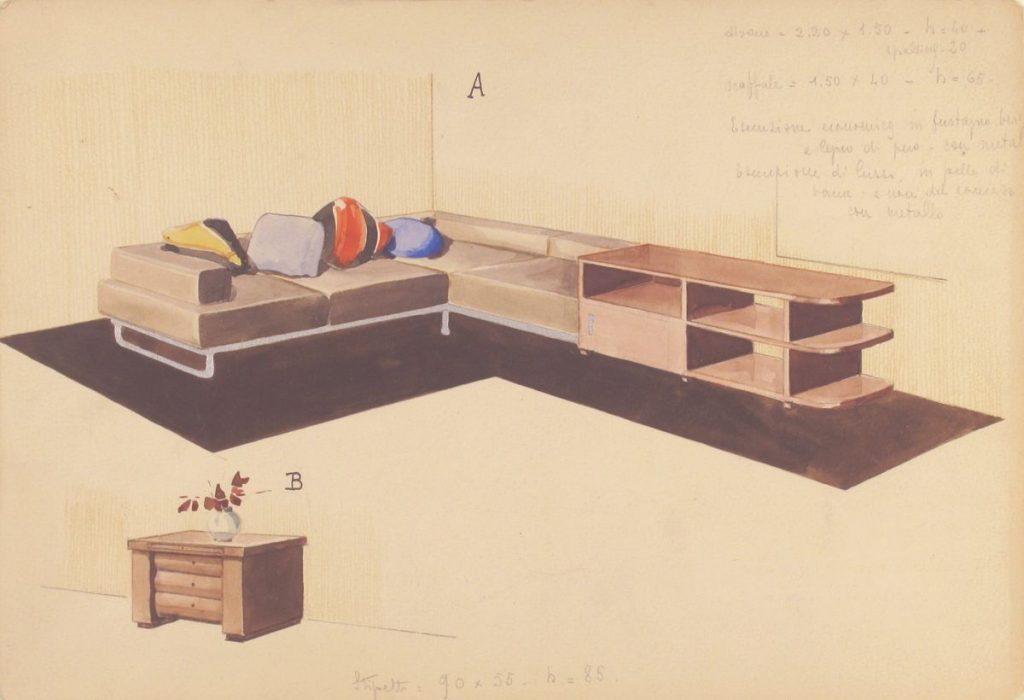
Guglielmo Ulrich, Divano, seoffale, e stipetto [Perspective of L-Shape Sofa and Storage Unit], 1933, watercolor and black and metallic ink, over graphite, sheet: 11 1/8 × 7 9/16 in. (28.2 × 19.2 cm). Collection of the Metropolitan Museum of Art.
ArtHistoryTeachingResources.org
Funding Sought: $4,000
Every day, across thousands of universities and high schools in the US, students learn about the history of art from prehistory to the present. Very rarely is design history incorporated into this curriculum. Art History Teaching Resources (AHTR)—a non-profit teaching resource site in the visual arts—wants to change this.
AHTR has collaborated with CAA’s Committee on Design to propose an initial collection of online teaching resources related to design history of the last two hundred years that will enable university-level and AP instructors to confidently teach them in foundational art and design history survey classes. The resources will be hosted online at arthistoryteachingresources.org in an area clearly marked as “design history” content.
Like AHTR’s existing resources already, the Design History Teaching Resources will include scholarly, well-researched, and peer-reviewed lecture outlines, image clusters, and bibliographies, as well as innovative digital videos and links to other Open Educational Resources (OERs) for students and teachers. The resources will remain freely accessible and open to all under a Creative Commons license.
To realize these resources AHTR needs to raise a modest sum of $4,000. If you might consider supporting this venture with a donation large or small, and would like to see the budget outline, timeline for completion, or any further details about the project, please contact: info@arthistorytr.org
Call for Papers: Art, Design & Society | CIHA India Colloquium 2018
posted by CAA — March 20, 2018

The National Museum Institute (NMI) in New Delhi, India. Image: Wikimedia Commons
New Delhi, India, November 27 – 30, 2018
Deadline: May 7, 2018
ART, DESIGN & SOCIETY
Comité International d’Histoire de l’Art (CIHA) India Colloquium 2018
Art and design are intrinsic to all forms with aesthetic value. In the modern world, the dichotomy between art and design was created by the socio-political and economic changes that were brought about by the industrial revolution and colonization. This has led to the paradoxical paradigm wherein the utilitarian designs of the past are perceived as art in the present and are displayed in museum spaces.
In countries like India, art institutions are products of colonialism which aimed at instilling western values leading to the collapse of traditional structures of art creation, dissemination and consumption. The living traditions of indigenous, popular and ritual art which formed the major corpus of artistic production in societies worldwide went unnoticed in the grand narratives. This led to the exclusion of a vast array of tangibles and intangibles that engendered incomplete perceptions of the past across the world.
This colloquium aims at bringing together the smaller narratives that have often been overlooked but which are nonetheless important parts of the tapestry of humanity. It has also become imperative that we re-examine the notions of art and design to understand the essence of the creative process across various cultures and encourage discussion and discourse on their interface and intersection with society. The colloquium particularly intends to probe the role of categorization and enquire into the very frameworks within which art & design operate.
Against this background, the colloquium would like to call for papers under the following topics:
- Design of the Past: Art of the Present
- Synthesizing the Sacred and the Secular
- Art & Design: Expressions of Conflict and Synthesis in Society
- Utility to Frivolity
- Space, Design & Art
- Power, Politics & Propaganda
- Sustainability: Practice and Production
- Vision, Perception and Interpretation
- Signs & Symbolism in Art & Design
- Prevailing Over Prejudice: Untold Stories
- Interpreting the Intangible Through the Tangible
- Impacting Society: Social & Digital Media
- Harmonizing the Individual and the Collective
- Art History: The Melting Pot
We invite paper presentations of 20 minutes. Please send a title of your proposed paper, an abstract of between 300 and 350 words. Please write the word “Abstract” in the subject line of your e-mail. Submissions must be sent to cihaindia2018@gmail.com
Closing date for the first call for papers: Monday, May 7, 2018
Kindly note that participation in the colloquium will only be confirmed after receipt of payment of registration fee. Click here to register.
CONVENERS:
Prof. (Dr.) Anupa Pande
Professor & Head, Department of History of Art
Director & Pro-Vice-Chancellor, National Museum Institute
Dr. Savita Kumari
Assistant Professor, Department of History of Art
National Museum Institute
Website: cihaindia2018.in
Introducing the New CAA
posted by CAA — February 27, 2018
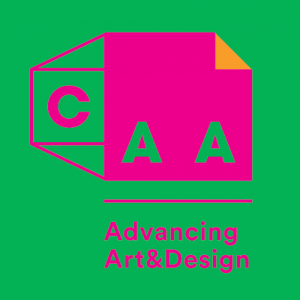
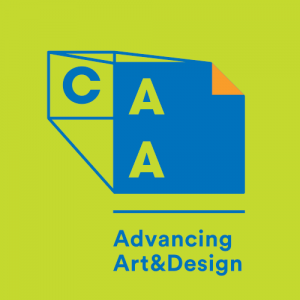
A New Look for CAA
As we look to build CAA in the future, with new and energized staff, new programs that will assist all of us in our professional lives, we have given the organization a new look and a name more focused on how our members know us after many years of service. We unveiled our new logo, new name, and new branding colors at the 106th Annual Conference last week in Los Angeles.
For decades, people have used the term “CAA” as a nickname for the Association. Many of our members feel connected to the words, College Art Association, but many others, especially new members and prospective members, feel these words don’t resonate with them. We started the renaming and rebranding process in spring of 2017 with the retention of a professional design and branding firm called Briteweb, which works exclusively with social sector organizations. This fall, as part of the research process, CAA and Briteweb held workshops, surveyed the current and past membership, and conducted interviews with long-standing and new members, as well as other arts professionals.
Nearly 1,500 members and members of the wider CAA community contributed to surveys and questionnaires about a new name and mark for the organization. As part of the process, we not only looked internally at our own membership but also at the marks of similar societies and organizations. To shepherd the process, CAA established a Branding Subcommittee, which reviewed and synthesized all of the ideas coming from membership and from Briteweb.
Last December we reached the first major milestone in the renaming and rebranding process. The Board, informed by member feedback, unanimously voted to simply call the organization CAA and to add a tagline ADVANCING ART & DESIGN to be used in coordination with the three letters.
Then we built a new logo. We built the new logo by thinking about the field, about our collective passions and interests, and the work we work we do every day. We narrowed down to two core components: the frame and the page. We used these symbols of the lives and work of our members as the building blocks of the new visual identity. They represent what we study, what we teach, what we practice, and what we create. We spend endless hours looking at, thinking about, writing about and reading about art.
We also wanted the idea of flexibility to be part of CAA’s new identity so we’ve adopted a logo system that can change as we do and as the field does. And the color palette was, of course, very important to us. We wanted to inject vibrancy and lots of color into our new logo system.
But change is more than a logo. This is about a shift in how we work to assist everyone in the field. A new look necessitates action. This is about more opportunities to present papers at the conference. This is about more opportunities to publish articles. It’s about more opportunities to network with colleagues. It’s about more opportunities to advocate for the field. It’s about beginning to think seriously about attracting otherwise marginalized communities to be part of the field.
This is the future of CAA.
A Brief History of 107 Years of Branding at CAA
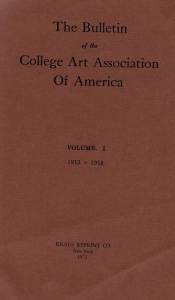
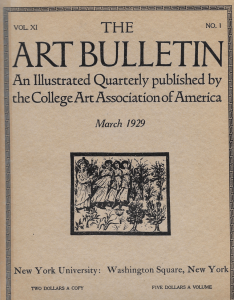
From its inception, the College Art Association understood the importance of its name. Publications like The Art Bulletin (founded in 1913) and Art Journal (founded in 1941) have proudly touted the name of the organization.
But formal branding and styling did not arrive until the 1950s when a modernist approach was adopted.
It was not until decades later, in the 1980s, that an official CAA logo took shape. The CAA logo of the 1980’s angled forward in all capital letters and had conjoined A’s.
In 2012, the CAA logo many know was born.
The new CAA logo dropped its height to use lowercase letters in a sans-serif font that was overlaid with swooping and intersecting lines.
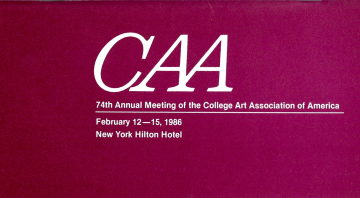

Murmurs and Decisions
For years, discussion has brewed among the CAA board of directors and members about a name change and new branding for the organization. The decision was formally written into the 2015-2020 CAA Strategic Plan.
In spring 2017, work officially began. CAA issued an RFP for the redesign and renaming of the 107-year old organization. The firm Briteweb, which specializes in branding for the social sector, was chosen as the best fit from eight other firms.
Step 1: Renaming
Feedback. Feedback. Feedback. The first step on the path to renaming the College Art Association (CAA) was gathering feedback from our members and stakeholders. A survey went out to all members, current and lapsed. Phone calls and interviews took place with stakeholders and board members. We learned a lot.
“Overall, it seems to me that the goal should be to figure out how to make sure that everyone who has a stake in teaching art, design, art history, curatorial and museum practices at the college level understand that they are included and welcomed—that it is their professional organization.” –CAA member survey response
Feedback we received from our members told us how CAA matters to them, where we can improve, and where we should focus our energy as we move into the future.
Step 2: A Tagline That Fits
Members told us that CAA has to move forward. You told us that we have to be there for the next generations of students and scholars in the arts and humanities. We have to advance the field by supporting the field. Our tagline was born.
“Advancing Art & Design”
We also learned that there was immeasurable value packed into three letters—CAA. We explored different acronyms, new names, and different words to fit CAA. But in the end, it came down to the letters CAA being the sole representation of the organization as it moves into the future, stepping up a role they have already played for decades.
Step 3: A Logo is Born
With our name settled, it was time to design. What does advancing mean visually? How can we encompass the many professions and personalities of our membership in a visual representation? Rounds of designs were reviewed.
We wanted risk, but not too risky.
The new CAA logo includes nods to the frame and page, two crucial elements of our members’ lives. It has dimensionality and flexibility. Just like our members.
Member Partner Designers and Books’ Kickstarter Campaign
posted by CAA — November 22, 2016
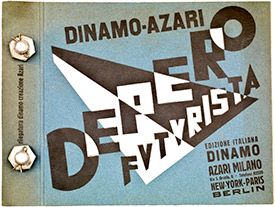 Depero Futurista, Dinamo-Azari, Milan, Italy, 1927, artist’s book bound with bolts, 32 x 24.2 cm. © 2016 Artists Rights Society (ARS), New York / SIAE Rome. Photo by Adam Reich
Depero Futurista, Dinamo-Azari, Milan, Italy, 1927, artist’s book bound with bolts, 32 x 24.2 cm. © 2016 Artists Rights Society (ARS), New York / SIAE Rome. Photo by Adam ReichOne of our Member Partners, Designers and Books, recently launched a Kickstarter campaign to raise funds to bring a classic design book back to life.
In 1927 Italian futurist artist Fortunato Depero developed what is still considered the first avant-garde artist book: Depero Futurista, commonly known as the Bolted Book. In an edition of fewer than 1,000 copies, this book is celebrated for its daring experiments in typography, innovative ideas about graphic design, and reinvention of the concept of the printed book (and yes– its binding is two steel bolts!).
You can explore this wonderful book, page by page, on the Bolted Book website.
Designers and Books is partnering with the Center for Italian Modern Art in New York and the MART Museum of modern and contemporary art of Trento and Rovereto to produce the first exact facsimile of Depero Futurista. The facsimile will include an accompanying readers’ guide, featuring essays from a variety of experts, original unpublished materials from the Depero archives at MART, and translations of selected pages of the book.
Your Kickstarter pledge toward this important piece of art and design history will be rewarded with an exact copy of The Bolted Book, the readers’ guide, and full acknowledgement of your support.
The least expensive Kickstarter reward tier currently available for a copy of the book is $141 (including US shipping). Acknowledging the special relationship of this book to the CAA community Designers and Books is making it available for a special price: $109 (plus shipping of $14 for a total of $123)——for a savings of $18.
Since this price is not available to the general public, here is how CAA members can secure a copy of the book for this special price:
1) Go to bit.ly/BoltedBook-Kick
2) Next to the video, click “Back This Project”
3) Click “Make a pledge without a reward”
4) Enter $123 and click “continue”
5) Log in or sign up, then complete the pledge as directed
6) Please email info@designersandbooks.com indicating your name, shipping destination, and the code “CAA.”
You will then receive a confirmation that you are registered for this special offer.
The Samuel H. Kress Foundation Funds Redesign of The Art Bulletin
posted by CAA — July 21, 2016
The College Art Association is pleased to announce a grant from the Samuel H. Kress Foundation to support a redesign of The Art Bulletin. CAA, the journal’s editors-in-chief, and its editorial boards have maintained unwavering attention to the quality of the journal’s scholarship for more than one hundred years of publication. Through the generosity of the Kress Foundation, the visual character of the print journal will gain a more contemporary and reader-friendly format, incorporating changes in the presentation of images and text, and an open, inviting look. CAA’s copublisher, Taylor & Francis, is also keen to assist with logistics and production support.
The first issue of The Art Bulletin slated for the new format is March 2017. The redesign is spearheaded by Nina Athanassoglou-Kallmyer, the new editor-in-chief of The Art Bulletin, who joined its editorial board in July. As she notes, “The journal not only represents our discipline and our professional association, but, even more, our wish to offer our members high-quality scholarship, a public platform, and a public profile that will earn them the recognition they merit on an international level.” Kallmyer is working closely with the journal’s editorial board, which identified key design elements during the course of several meetings, as well as with CAA staff.
CAA remains firm in its commitment to excellent scholarship in the print and online versions of its flagship journal, and is grateful to the Kress Foundation for making the redesign of the journal possible.
CAA Announces Formation of Committee on Design
posted by CAA — February 23, 2016
Dear College Art Association Members:
In 2015, CAA established a Task Force on Design charged with suggesting positions the organization might adopt toward design, design studies, designers, design educators, historians, and theorists. The CAA Board of Directors is delighted to announce the approval of a new Committee on Design, approved during the recently concluded 2016 CAA Annual Conference.
The Committee will replace the Task Force and be among CAA’s ten standing Professional Interests, Practices, and Standards Committees. The Committee on Design will promote and advance issues in design practice, design history/theory/criticism, and design education through advocacy, engagement, and a commitment to the diversity of practices and practitioners. The committee will further support discussion and action in these areas to stimulate intellectual curiosity and advance skills that enrich the individual and society.
CAA invites members to apply for service on this inaugural Committee on Design. To apply, kindly forward a statement of interest (250 words or less) and a 3–4 page condensed résumé noting in the subject line Committee on Design to vjalet@collegeart.org. Initial application review begins on March 30, 2016, with appointments to two-year terms anticipated by May 1, 2016.
Until May 1, the Task Force on Design will continue work on revising CAA’s Standards and Guidelines for Retention and Tenure of Art and Design Faculty and seeks input from CAA members. We invite you to review and comment upon the current draft. Please send any comments and/or questions to designfeedback@collegeart.org.
Responses at your earliest convenience, and especially prior to March 15, 2016, are greatly appreciated as the Task Force wishes to complete this project for a May 2016 approval by the CAA Board of Directors.
Thank you in advance for input toward advancing design interests within CAA.
Sincerely,
DeWitt Godfrey,
President
Jim Hopfensperger, Chair,
CAA Task Force on Design



